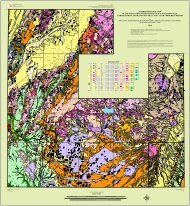Wetlands in northern Salt Lake Valley, Salt Lake County, Utah
Wetlands in northern Salt Lake Valley, Salt Lake County, Utah
Wetlands in northern Salt Lake Valley, Salt Lake County, Utah
You also want an ePaper? Increase the reach of your titles
YUMPU automatically turns print PDFs into web optimized ePapers that Google loves.
<strong>Wetlands</strong> <strong>in</strong> Northern <strong>Salt</strong> <strong>Lake</strong> <strong>Valley</strong>, <strong>Salt</strong> <strong>Lake</strong> <strong>County</strong>, <strong>Utah</strong>—an evaluation of the threats posed by ground-water developement and drought 9(modified from Lambert and others, 1995).Figure 6. Recharge and discharge areas, <strong>Salt</strong> <strong>Lake</strong> <strong>Valley</strong> (modified from Anderson and others, 1994).ited Use ground water, and 12% is classified as Sal<strong>in</strong>e groundwater (Wallace and Lowe, 2009) (figure 8). Ground water <strong>in</strong>the pr<strong>in</strong>cipal aquifer generally has lower TDS concentrationsthan water <strong>in</strong> the shallow unconf<strong>in</strong>ed aquifer (Hely and others,1971).Total-dissolved-solids concentrations for ground water <strong>in</strong> theshallow unconf<strong>in</strong>ed aquifer range from 331 mg/L <strong>in</strong> the easternportion to 20,900 mg/L for the western portion of the valley(Thiros, 1995). The proximity to land surface, evapotranspiration,dissolution of m<strong>in</strong>erals, and recharge from water divertedfrom the Jordan River create more localized variationsand higher dissolved-solids concentrations <strong>in</strong> water from theshallow unconf<strong>in</strong>ed aquifer (Hely and others, 1971; Thiros,1995). Chloride concentrations have steadily <strong>in</strong>creased <strong>in</strong> thepr<strong>in</strong>cipal aquifer, probably from salt used for de-ic<strong>in</strong>g roads(Thiros, 1995).Ground water between the mouth of B<strong>in</strong>gham Canyon andthe Jordan River has been contam<strong>in</strong>ated by seepage fromevaporation ponds associated with m<strong>in</strong><strong>in</strong>g activities (Helyand others, 1971). The contam<strong>in</strong>ated ground water is acidic
















